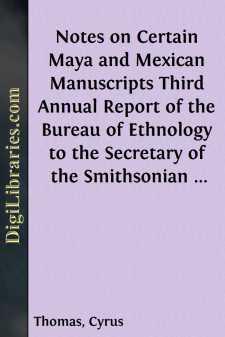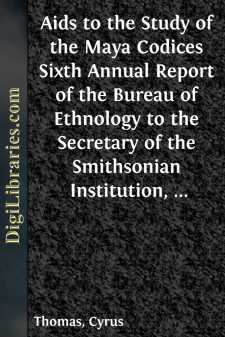Categories
- Antiques & Collectibles 13
- Architecture 36
- Art 48
- Bibles 22
- Biography & Autobiography 813
- Body, Mind & Spirit 142
- Business & Economics 28
- Children's Books 17
- Children's Fiction 14
- Computers 4
- Cooking 94
- Crafts & Hobbies 4
- Drama 346
- Education 46
- Family & Relationships 57
- Fiction 11829
- Games 19
- Gardening 17
- Health & Fitness 34
- History 1377
- House & Home 1
- Humor 147
- Juvenile Fiction 1873
- Juvenile Nonfiction 202
- Language Arts & Disciplines 88
- Law 16
- Literary Collections 686
- Literary Criticism 179
- Mathematics 13
- Medical 41
- Music 40
- Nature 179
- Non-Classifiable 1768
- Performing Arts 7
- Periodicals 1453
- Philosophy 64
- Photography 2
- Poetry 896
- Political Science 203
- Psychology 42
- Reference 154
- Religion 513
- Science 126
- Self-Help 84
- Social Science 81
- Sports & Recreation 34
- Study Aids 3
- Technology & Engineering 59
- Transportation 23
- Travel 463
- True Crime 29
Day Symbols of the Maya Year Sixteenth Annual Report of the Bureau of American Ethnology to the Secretary of the Smithsonian Institution, 1894-1895, Government Printing Office, Washington, 1897, pages 199-266.
by: Cyrus Thomas
Categories:
Description:
Excerpt
INTRODUCTORY
As the origin and signification of the day and month, names of the Maya calendar, and of the symbols used to represent these time periods, are now being discussed by students of Mexican and Central American paleography, I deem it advisable to present the result of my investigations in this line. The present paper, however, will be limited to the days only, as I have but little to add in regard to the month names or symbols. As the conclusion reached by Drs Seler and Brinton in regard to the order and sequence of the days of the month in the different calendars appears to be satisfactorily established, it will be accepted.
As frequent allusion is made herein to the phoneticism or phonetic value of the written characters or hieroglyphs, it is proper that the writer’s position on this point should be clearly understood. He does not claim that the Maya scribes had reached that advanced stage where they could indicate each letter-sound by a glyph or symbol. On the contrary, he thinks a symbol, probably derived in most cases from an older method of picture writing, was selected because the name or word it represented had as its chief phonetic element a certain consonant sound or syllable. If this consonant element were b, the symbol would be used where b was the prominent consonant element of the word to be indicated, no reference, however, to its original signification being necessarily retained. Thus the symbol for cab, “earth,” might be used in writing Caban, a day name, or cabil, “honey,” because cab is their chief phonetic element.
In a previous work I have expressed the opinion that the characters are to a certain extent phonetic—are not true alphabetic signs, but syllabic. And at the same time I expressed the opinion that even this definition did not hold true of all, as some were apparently ideographic, while others were simple abbreviated pictorial representations. In a subsequent paper I expressed substantially the same opinion, and gave as my belief that one reason why attempts at decipherment have failed of success is a misconception of the peculiar character of the writing, which peculiarity is found in the fact that, as it exists in the codices and inscriptions, it is in a transition stage from the purely ideographic to the phonetic. I stated also my belief that the writing had not reached the stage when each sound was indicated by a glyph or sign.
This may further be explained by the following illustration: The conventionalized figure of a turtlehead is the symbol for a “turtle,” ak, ac, or aac in Maya; and a conventionalized footprint is the symbol for “step” or “road,” be, beil, in Maya. These may be brought together to form the word akyab or kayab, which may have no reference to the original signification of the combined symbols. These two glyphs are, in fact, combined to form the symbol for the month Kayab.
These statements will perhaps suffice to make clear my views on this question, which do not appear to have been clearly understood, possibly because of my frequent use of the words “phonetic” and “phoneticism,” and perhaps rather loose reference to “letter elements.”
It is proper, however, to add that I am inclined to the opinion that modification in the form and details of a glyph which belongs to the class which, for want of a better term, we may designate “phonetic,” in many cases indicates a modification or change in the signification or word value. I say in “many cases,” because these modifications are due often to the greater or lesser accuracy with which the glyph is drawn, the caprice of the scribe, and other causes which have no reference to sound or signification. For example, the change of a rounded or circular symbol to a face figure, as is often done, does not appear, at least in the day signs, to have any significance. On the other hand, a slight variation, if permanent, may be indicative of a difference in signification or phonetic value. This appears to be true, to some extent, whether we consider the characters ideographic or as, in some sense, phonetic.
The lists of the days in the Maya, Tzental, Quiche-Cakchiquel, Zapotec, and Nahuatl, in the order usually given, are as follows:
Names of the days in the different calendars
MayaTzentalQuiche-CakchiquelZapotecNahuatlImix.Imox.Imox.Chilla.Cipactli.Ik.Igh.Ik’.Gui, Ni, Laa.Ehecatl.Akbal.Votan.Akbal.Guèla.Calli.Kan.Ghanan.K’at.Guache.Cuetzpallin.Chicchan.Abagh.Can.Ci, Ziie.Cohuatl.Cimi.Tox.Camey.Lana.Miquiztli.Manik.Moxic.Quch....




